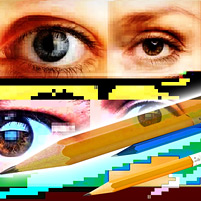What We (Want To) See

If you are looking for a particular object — say a yellow pencil — on a cluttered desk, how does your brain work to visually locate it?
For the first time, a team led by Carnegie Mellon University neuroscientists has identified how different neural regions communicate to determine what to visually pay attention to — and what to ignore.
This finding is a major discovery for visual cognition and will guide future research into visual and attention deficit disorders.
The study, published in the Journal of Neuroscience, used various brain imaging techniques to show exactly how the visual cortex and parietal cortex send direct information to each other through white matter connections in order to specifically pick out the information that you want to see.
"We have demonstrated that attention is a process in which there is one-to-one mapping between the first place visual information comes from the eyes into the brain and beyond to other parts of the brain," said Adam S. Greenberg, postdoctoral fellow in the Dietrich College of Humanities and Social Sciences' Department of Psychology and lead author of the study.
"With so much information in the visual world, it's dramatic to think that you have an entire system behind knowing what to pay attention to," said Marlene Behrmann, professor of psychology at CMU and a renowned expert in using brain imaging to study the visual perception system.
"The mechanisms show that you can actually drive the visual system — you are guiding your own sensory system in an intelligent and smart fashion that helps facilitate your actions in the world."
The researchers used a technique called "Diffusion Spectrum Imaging," to generate the fiber maps of the white matter connectivity.
This gives researchers access to the structural characteristics of brain tissue — something previously only available in humans during autopsy.
This method was combined with high-resolution tractography, a new procedure undertaken in Pittsburgh, which allows scientists an extremely detailed estimate of the hard-wired connections between brain regions; providing increased accuracy over conventional tractography methods.
"The work done in collaboration with the University of Pittsburgh researchers exploits a very new, precise and cutting edge methodology," Behrmann said.
"Because we know that training can alter white matter, it might be possible, through training, that the ability to filter out irrelevant or unwanted information could be improved," Greenberg said.
The National Institutes of Health funded this research.
Related Links: Press Release | Brain Art | Brain, Mind & Learning | Dietrich College
